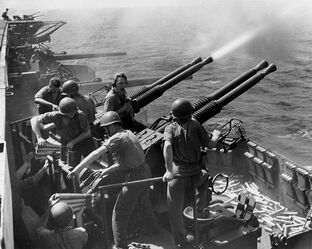
A battery of Bofors 40 mm guns firing from the USS Hornet.
The Bofors AA gun is a multipurpose autocannon that is primarily used as an anti-aircraft weapon. It was developed in 1934 by the Bofors company in Sweden, and was one of the most successful AA guns in the world by the time World War II began.[1] During the conflict, the 40 mm was used by both the Allies and the Axis, particularly by Great Britain and the United States. It was such a versatile and useful weapon that it is still used today in a variety of roles.
Description[]
While there were many variants of the Bofors AA gun, it generally had a fire rate of 120 rounds per minute, and a muzzle velocity of 853 meters per second.[1] The main variant used by the Allies during World War II was designated the QF Mark III Army which was developed by the British from Polish improvements to the platform. It was commonly mounted on naval vessels in addition to being used as towed artillery on the battlefield. The maximum range of the weapon was around 7,100 meters.
The total weight of the weapon was around 1,980 kilograms including carriage while its total length was around 1.9 meters. On its typical mount, the Mark III could elevate from -5 degrees to 90+ degrees.[2] To aid with gun direction, a special computer was used, known as the Kerrison Director, it greatly aided in accuracy and with a hydraulic mount, the Bofors was capable of effectively disabling the modern aircraft it fought against.
The Americanized variant of the Bofors was known as the Mark 1 (Mark 2 being the right side gun on the double mounting used with the Bofors. The weapon was fed from the top by curved magazines.[3] Used with the weapon were commonly HE-I-T rounds or High Explosive Incendiary Tracer.[4] Crew sizes varied, with at least two being required for sighting and aiming and a third and fourth for loading depending on if the gun was a dual mount. In reality, the only variants of the Bofors weapon system that were produced during World War II were all designed to either remove or add guns to the platform or improve sighting.
History[]
The Bofors AA gun was initially developed in 1922 by the Swedish following their aquisition of Vickers 2-pounder "Pom Pom" anti aircraft gun. While the "Pom Pom" was accepted for service onboard Swedish ships, the military requested its native Bofors to develop a better anti-aircraft weapon. The result was the Bofors AA gun, also known as the 40mm L/60, entering service in 1933. Immediately, the Bofors was requested by numerous countries around the world.

A Canadian Bofors team operating a single barrel L/60 in Normandy, 1944
It wasn't until 1937 that the British first received their first Bofors AA gun. Once the appropriate modifications had been made to the weapon, the Bofors was accepted as the standard light anti-air gun of the British. While production was slow, it was highly praised in the early campaigns of 1940, protecting against German air superiority whenever possible. At the same time, the US had purchased examples in 1940 for examination.
Production was then carried out illegally until a formal agreement could be made. Nonetheless, the Bofors AA gun was also one of the standard AA guns of the United States, being especially favored among ships. To pick up the production, Chrysler was tasked with mass production, creating over 60,000 Bofors by the end of the war. Another 2,000 examples were built by Britain and Canada.
References[]
| |||||||||||||||||||||||||||||||||||||||||||||||||||||||||||
